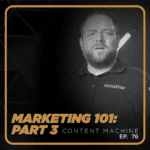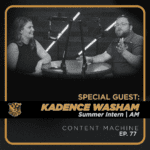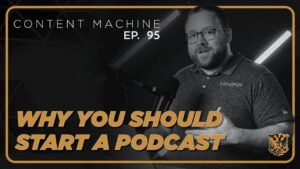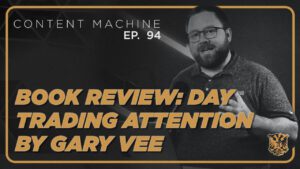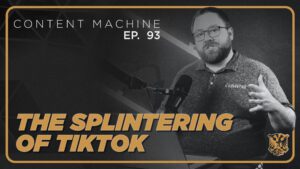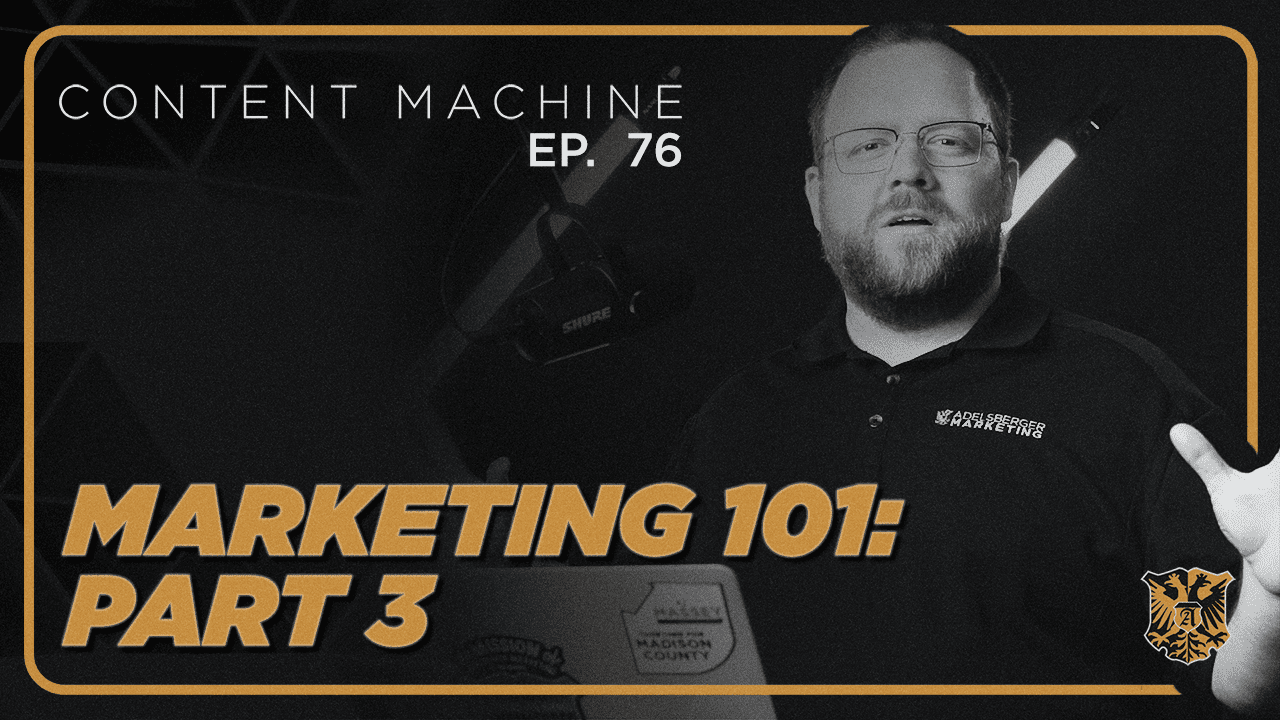
Welcome to the third part in our series about Marketing Fundamentals, a marketing 101 with the Content Machine podcast. We’ve talked about some of the fundamentals of marketing. Let’s talk about paid media. A couple of versions of paid media. First thing we’ll talk about is sponsorship. Community involvement is great, but is at our target audience. You can think about things of who is attending the events or who’s also supporting this nonprofit that we’re supporting. It’s a great way to build relationships in the community. But we also should ask the question, what are we saying to the community by sponsoring this? And how can we make the most of this sponsorship? First thing, be present at the event. It’s embarrassing for people to have a table at an event and then nobody be sitting at it. Now, let’s think about traditional advertising, newspapers, radio, TV. The first question you should ask is, does the cost justify the attention that you’re getting? Are the people that we want to talk to consuming this product? And what stats are we relying on to know if this is reaching a good amount of people? I’m cautious about stats for radio and TV in local markets because a lot of times they are based on Nielsen ratings, or some markets don’t have Nielsen ratings and rely on people voluntarily telling you what they’re watching and listening to.
People are incredibly unreliable on that thing. But then the bigger The question is, are the people we’re trying to talk to, listening to, watching or reading this material? That’s something you have to think about for yourself. With digital marketing, it’s a similar set of questions. Does the cost justify the attention? Typically, On most digital marketing platforms, it is cheaper per thousand people reached than traditional media. But if you go to something like influencers, the cost may go up significantly. So do we have the content to here as well. When you start doing things like YouTube ads or TikTok ads, you have to have video to go with those things. Do you have good enough video to go with those products to help sell yourself? And the big question is, is our target market actually looking here? Are the people we’re trying to talk to on this platform and spending time here? I will also say that not all digital ads are created equal. Banner ads versus content ads are very different things. A banner ad on a random app that you install, like a weather app, for example, does not have the same ROI as a good video ad on YouTube.
So be thinking about the placement of those ads and who’s going to be seeing them. You should also think about getting out and networking. Can you network with your target audience? Chambers of commerce, realtor groups, trade groups? Maybe you can create a group, like a networking group on Facebook or a LinkedIn, or is there some regional group that you can be a part of? Getting out and meeting people is still a great way to develop business. And then finally, a big concept that you should think about is the splinterization of our media lives. Media attention is splintered. If you interviewed a room of 20 random people, they probably listened to 20 different things on the radio or through music, through speakers on the way into the office that day. The media attention is no longer focused in a couple of different spots. It’s spread all over the place. And so you need to be able to think about that not everybody is How are we going to be reading the thing or listening to or watching to the thing that you’re running ads on. How do we increase our touch points and touch more people with our marketing message?
You have to be able to spread out your balance of your marketing budget But focus on the areas that are the most beneficial through tracking over the long term. A good concept to keep in mind throughout the marketing process is developing know, like, and trust with customers. So know is creating the outbound awareness of your business. Do people know that you exist and that you sell the product that you do? Have they heard your name before? Do they know some friends that have worked with you or hired you or bought your products? This is where outbound marketing comes in, where we’ve got the audience that we want to talk to, We’ve spent money and we’ve done something that’s good for our brand image. It creates awareness of our business so that we’ve hit that first contact. You hear that old saying, people have to hear your name seven times before they do business with you. That initial interaction Introducing them to know that you exist, that’s in the no category. The second category is, do they like you? Communicating who you are and who you work for is a key part to know if they like you or not.
This is also a good time to introduce social proof. Can you show testimonials of people that have worked with you or finished projects that you’ve done that they may have seen or can appreciate what you’re doing so that they can understand that you’re worth doing business with? If you can humanize the business, this is a great time to do that as well. Will you introduce that the people behind the business is not just this nameless faces Corporation. It’s a group of people doing a thing. And then finally, if you have any affinities that you want to signal that you might share with people, so maybe you’re super patriotic, or maybe you’re super involved in your local school system, or maybe you have a certain nonprofit that you’re very much attached to. Here’s a great place that as you share that information, you could be helping build a relationship with people that you don’t even know that you’re talking to yet. Now, I will say there’s some affinities that can turn people off as much as they turn someone into a friend of your customers. So just keep that in mind depending on what you’re leaning into.
And then finally, we want to build the trust. So know trust. So trust, can we show our experiences? General, we’ve done business for 40 years, and specific where, Hey, we’ve worked with banks under this dollar amount doing this service for the last 15 years. That trust can show the success, but also shows that you know what you’re talking about. And additional trust symbols could be chamber memberships, better business, bureau memberships, Google reviews, clutch reviews, things that help show that you have a track record of being a trustworthy business to do work with. Sharing a clear path to success, the different steps it takes, removes some of the mystery of what it means to do business with you and how to get to the place where they want to be. And then also, I would say being real, not using stock photos, not hiding leadership on the site or in public, and not being fake. These are all things that help build trust, which will help you close your deal. Now, at Adelsberger Marketing, we have three main pillars of marketing that we’ve tried to do over the last 10 years to help us be successful.
The first one is building stark raving fans. We want everyone who does business with us to tell all their friends that they had a great experience working with Adelsberger Marketing. We do that by doing the best we can to deliver on the projects that we say we’re going to do when we say we’re going to do them as much as it’s in our control. And we always take the hit for people. An example I always give is I had a customer who ordered business cards, and he sent me the information. I made the business cards. I approved them. He proofed them, sent them to order. He got them, called me, and said, Hey, the phone number’s wrong on these cards. Some businesses would say, Hey, you approved them, you’re out the money. I went ahead and fixed them because I knew that if I took care of him, he would be a fan. And for many years after that, he would tell anybody he that they should do business with us, and was a great supporter of my business. We also believe in being part of the community. We invest in nonprofits in our community.
We invest in community activities. We want to make our area a better place to live because a rising tide floats all boats. It’s also a great place to get to know people and start relationships that will lead to new business in the future. And finally, we want to educate as much as we can. So what reason we do this podcast or we go do talks at different chambers? We want to be seen as experts in marketing, and we do that by teaching other people about marketing. You may have some questions about marketing. I’d encourage you to come to office hours with me. If you go to the Co’s website, you can find an opportunity to get a free 30-minute call with me to ask me whatever questions you might have about marketing. But here’s a couple of books that I’d recommend in the meantime as well. Story Brand by Donald Miller is a great way to think about messaging and developing a one-liner for your business. Juicing the Orange by Fallon is a book that does a great job of a company showing how they built several campaigns over the last couple of decades and the thought processes that they took into creative that was motivating to customers.
Jab, jab, jab, right hook, or really Anything by Gary Vandertruck is a really excellent resource to think about how marketing works in our current era. Anything by Seth Godin is worth your time to read. A really interesting book about the way our attention works is Attention Merchants by Tim Wu. I recommend that book to help you think about how to capture people’s attention and, frankly, how to protect your own. Culture Built My Brand by Miller is a great book that helps you think about how to build a company that is acting in a way that customers want to work with and do better. So that is the end of our three-part series on How to Do Marketing 101. If you have any additional questions about marketing, please send me an email at kevin@adelsburgermarketing. Com, or sign up for an office hour’s visit at The Co and get 30 minutes of free marketing consultation from me. Thank you joining us for this episode of the Content Machine podcast. We hope to see you in future episodes.

